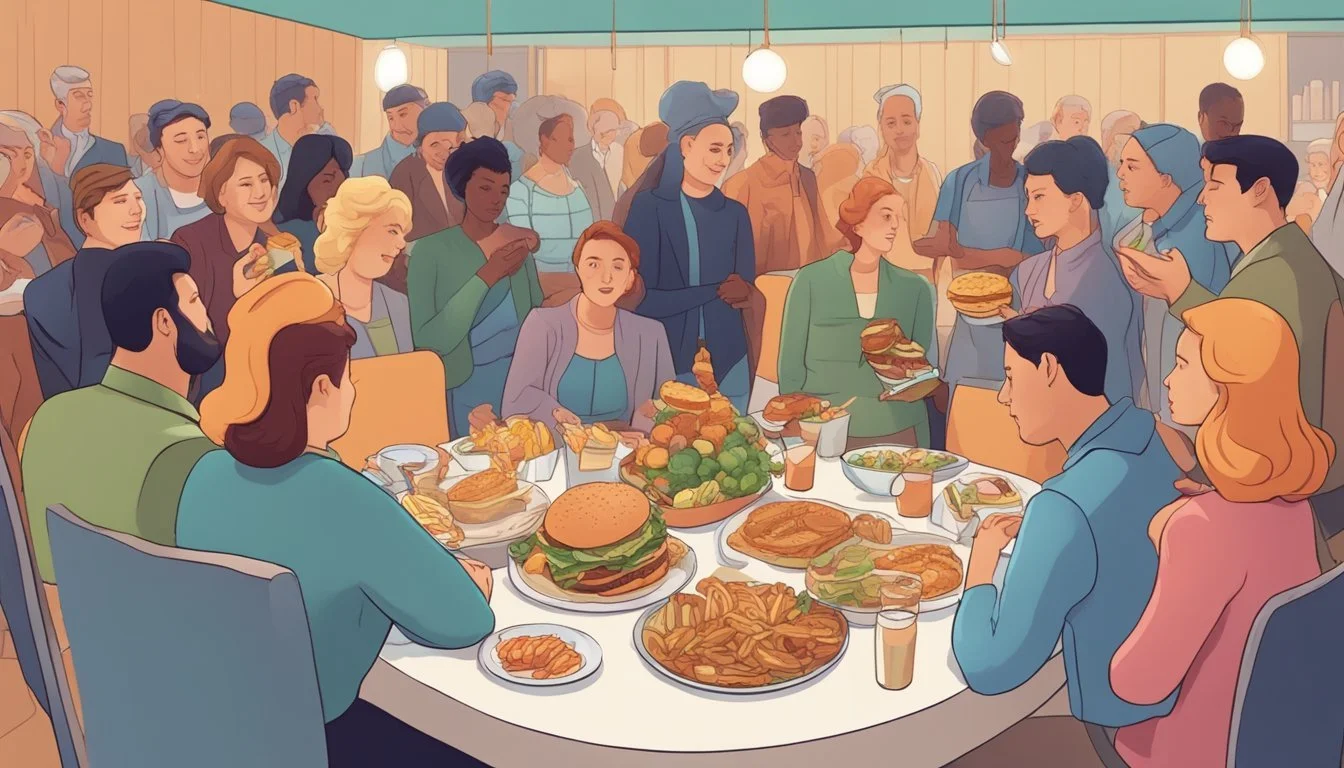High-Fat Diet: Navigating Social Pressure With Ease
Adopting a high-fat diet, often known as a ketogenic diet, involves a significant shift from the traditional high-carb dietary norm. This regimen emphasizes fats as the primary source of fuel for the body, altering the metabolic process to favor fat breakdown over carbohydrates. While scientific studies highlight the potential benefits of a high-fat diet including improved weight management and cognitive function, adherents frequently encounter social pressure. Social gatherings and peer influences can challenge an individual's commitment to this restrictive dietary pattern.
Social pressure can manifest in various forms, from well-meaning friends offering high-carb treats to outright criticism of dietary choices. Maintaining a high-fat diet in such circumstances requires not just strong willpower but also strategic planning. People navigating social situations while following a high-fat diet often find success by preparing themselves in advance, such as eating a satiating meal before attending events to avoid temptation. Equipped with knowledge about nutrient-dense foods that align with their diet, they can confidently make choices that support their health goals.
The stress associated with resisting social pressure can be significant, yet it's essential for individuals to remain resolute in their dietary choices to reap the intended benefits. Strategizing ways to handle temptations and social expectations, such as bringing their own suitable snacks to gatherings or offering to contribute a high-fat dish, empowers people to stay aligned with their dietary goals. Maintaining a high-fat diet in the face of social pressure is an exercise in personal conviction and requires a balance of nutritional knowledge, social finesse, and self-advocacy.
Understanding High-Fat Diets
A high-fat diet typically consists of a substantial proportion of calories from fats. Knowing the types of fats and their effects on the body is essential for informed dietary choices.
Types of Fats: Saturated, Unsaturated, and Trans Fats
Saturated fats are found in animal products and certain oils, and they remain solid at room temperature. Examples include butter and coconut oil. Unsaturated fats, which are liquid at room temperature, are further categorized as either monounsaturated or polyunsaturated fats. Olive oil is rich in monounsaturated fats, while sunflower oil contains polyunsaturated fats. Within polyunsaturated fats, there are essential fatty acids like omega-6 and omega-3 fatty acids, vital for numerous body functions and must be obtained from the diet.
Trans fats are another type of fat, often created through hydrogenation, which can be found in processed foods. They are associated with negative health impacts, including raising the risk of heart disease.
The Role of Fatty Acids in the Body
Fatty acids serve several crucial roles in the body. They are key components of cell membranes, aid in nutrient absorption, and provide energy. Specifically, fatty acids are integral to maintaining healthy skin and producing hormones. Additionally, some fatty acids, like omega-3 fatty acids, are anti-inflammatory and can support cardiovascular health, whereas an excess of omega-6 fatty acids may lead to inflammation if not balanced with omega-3s.
Dietary Fat and Health Relations
The relationship between dietary fat and health is complex. While saturated fatty acids were once thought to directly correlate with heart disease, recent studies indicate that the relation may not be as straightforward. However, it's generally agreed that a diet high in trans fat is harmful, contributing to an increased risk of heart disease and negatively affecting cholesterol metabolism.
Conversely, certain types of fat are beneficial. For example, diets rich in polyunsaturated fatty acids, including both omega-3 and omega-6, can improve heart health. It's important for individuals to balance their fat intake, considering the diversity of effects each type of fat has on the body.
The Psychological Impact of Dietary Choices
Dietary choices can affect one's mental health, influencing mood, stress responses, and susceptibility to mental disorders. It is critical to understand how certain diets interact with the body's psychological mechanisms.
Food Intake and Mental Disorders
Dietary patterns can influence the development and course of mental disorders. Research indicates that diets high in fruits, vegetables, nuts, and legumes and lower in red meat are associated with a reduced risk of depression. Contrarily, high-fat diets can affect the hypothalamic-pituitary-adrenal (HPA) axis, which is pivotal in stress regulation. An imbalance in the HPA axis can lead to dysregulation of corticosterone and CRH (corticotropin-releasing hormone), both of which are involved in the stress response and could potentially exacerbate mental health issues.
Stress Responses and Comfort Foods
Chronic stress can alter food preferences, often leading people to seek out comfort foods. These tend to be high in fat and sugar, providing temporary relief but potentially disturbing the HPA axis balance over time. The consumption of these foods during periods of stress can create a feedback loop that perpetuates craving cycles and may affect mental well-being.
The Effects of Diet on Anxiety and Depression
Dietary interventions can modify anxiety and depression levels. For example, calorie-restricted diets have been shown to decrease depression scores. Conversely, diets high in saturated fats and processed foods might exacerbate symptoms of anxiety and depression by influencing inflammation and oxidative stress pathways, which can negatively affect brain function.
Nutritional Science and Metabolic Health
Nutritional science plays a pivotal role in understanding metabolic health, shedding light on how high-fat diets influence metabolic disorders and how nutrients are metabolized, along with the beneficial impact of exercise on metabolic regulation.
Implications of High-Fat Food on Metabolic Disorders
A diet high in saturated fats is linked to an increased risk of metabolic disorders, such as type 2 diabetes, cardiovascular disease, and obesity. These diets can lead to insulin resistance, a condition where cells in the body become less responsive to insulin, impeding effective glucose regulation. Visceral obesity, characterized by excess fat around the abdomen, can exacerbate metabolic complications due to its influence on hepatic lipid metabolism and systemic inflammation.
How the Body Processes Different Nutrients
The hypothalamus plays a central role in nutrient metabolism, coordinating appetite and energy expenditure. Carbohydrates are typically broken down into glucose, which cells use as energy. Proteins are metabolized into amino acids, supporting cell growth and repair. Fats, particularly those from high-fat foods, can be stored in adipose tissue and are metabolized differently, which can impact metabolic health if consumed excessively.
The Role of Exercise in Metabolic Regulation
Incorporating physical activity and voluntary exercise into one's lifestyle is crucial for maintaining metabolic health. Regular exercise improves insulin sensitivity, enhances glucose uptake by muscles, and boosts overall metabolic rate. Moreover, physical activity helps to manage body weight, reduce visceral fat, and lower the risk of developing metabolic disorders.
Social Dynamics and Eating Habits
Adhering to a high-fat diet introduces unique challenges within social settings, where social pressures and stress can significantly influence eating behaviors. Individuals often face psychosocial stress and may adopt varying coping mechanisms to maintain dietary goals amidst social-eating environments.
Navigating Social Situations with Dietary Restrictions
Social pressure can heavily sway an individual's food choices. In situations where high-fat or large portioned meals are the norm, it can be difficult for someone to adhere to a different dietary regimen without feeling ostracized. Implementing strategies such as pre-eating a healthy meal or suggesting restaurants with diverse menu options empowers individuals to maintain control over their food consumption.
Pre-eating before social gatherings
Proposing restaurants with healthy choices
Psychosocial Stress and Eating Patterns
Exposure to psychosocial stress often correlates with an increase in craving for high-fat or sugary foods as a form of comfort. Social-defeat stress could lead to overconsumption as individuals seek to counteract negative emotions. Proactive stress management, like engaging in physical activity or mindfulness practices, aids in mitigating stress-induced eating.
Counteracting stress through exercise
Mindfulness to reduce food cravings
Coping Mechanisms for Social-Eating Challenges
Developing coping mechanisms is crucial to withstand social-eating challenges. One effective tactic is asserting dietary choices confidently, which lessens the likelihood of succumbing to peer influence. Additionally, forming social connections with those who support or share similar nutritional goals reduces social avoidance behavior, enhancing compliance to dietary restrictions.
Asserting dietary choices confidently
Connecting with supportive individuals
Healthful Alternatives and Adaptations
To support a high-fat diet within social settings, one must prioritize healthful alternatives that still align with dietary goals. Below are strategies focused on macronutrient balance, adopting the Mediterranean diet principles, and integrating regular physical activity.
Balancing Macronutrients for Optimal Health
Individuals should distribute their daily caloric intake across macronutrients—fats, proteins, and carbohydrates—to foster fat adaptation while maintaining health. Healthy fats, particularly monounsaturated fats like olive oil and avocados, are crucial. A recommended range is 50-75% of calories from dietary fat, 20-30% from protein, and the remaining from carbohydrates, primarily in the form of fiber-rich vegetables and nuts.
The Mediterranean Diet as a Model
The Mediterranean diet exemplifies a high-fat approach that is both viable and socially acceptable. It emphasizes:
Monounsaturated fats from olive oil
Nuts for snacking and meal enhancement
Abundant fiber from fruits, vegetables, and legumes
Regular consumption of fish, providing omega-3 fatty acids
Calories from these sources are nutrient-dense, supporting the body’s needs while aligning with a high-fat lifestyle.
Incorporating Physical Activity into Lifestyle
Physical activity should complement a high-fat diet to maximize overall health benefits. Regular exercise, ranging from moderate to high intensity, can help manage caloric balance and enhance metabolic adaptation to dietary fat. It's not only about reducing calories; it’s about strengthening the body's ability to utilize fats efficiently.
Challenges of a High-Fat Diet in Today's Society
Adhere to a high-fat diet can conflict with societal norms, especially given the rising concerns about obesity and lifestyle diseases. Individuals may face scrutiny for their dietary choices and find it difficult to maintain their regimen amidst a food industry that heavily markets processed foods.
The Obesity Epidemic and High-Fat Consumption
The global obesity epidemic is inextricably linked to the intake of high-fat foods. Diets rich in lard and butter contribute to an energy-dense intake, often exceeding an individual’s caloric needs. In a society where obesity is a considerable health issue, those adhering to a high-fat diet may experience social backlash and pressure to conform to low-fat dietary patterns.
The Influence of Processed Foods and Eating Out
Eating out often exposes individuals to processed foods laden with fat, sodium, and calories. Palatable foods in restaurants and fast-food chains are designed to appeal to taste but can make it challenging to stick with a high-fat diet that is intended to be nutritious and balanced. Individuals must meticulously choose their meals, often requiring them to navigate through a maze of unhealthy options.
Strategies to Resist High-Energy-Dense Foods
To resist high-energy-dense foods, which are ubiquitous in today's food landscape, individuals may:
Identify and avoid: Recognizing high-fat processed options that do not align with their dietary goals.
Prepare in advance: Bringing homemade meals or snacks to social events, which ensures control over the ingredients and fat content.
Educate: Informing peers and family about their diet's rationale can sometimes reduce social pressure and increase support.
These strategies enable individuals to remain steadfast in their dietary choices against the social currents favoring more indulgent, less nutrient-dense food options.
Conclusion
Adhering to a high-fat diet in a social setting demands both planning and confidence. Individuals may confront challenges such as peer pressure and the temptation of non-compliant foods. They must navigate social situations gracefully while maintaining their commitment to their dietary choices.
To mitigate health risks, individuals should ensure they are obtaining necessary vitamins and nutrients, which may be lacking in a high-fat diet. A strategy is to consume a variety of fats from multiple sources, aiming for a balance of saturated, monounsaturated, and polyunsaturated fats. Moreover, being aware of the potential for an increase in sugars and processed foods to compensate for the reduction in carbohydrate intake is crucial for maintaining overall health.
Addressing hunger at social events can be done by eating a small meal before attending or bringing a healthy dish to share. This approach helps to avoid overindulgence in foods not aligned with the individual's dietary goals. It allows for satisfying social expectations without compromising health objectives.
In summary, individuals can uphold a high-fat diet during social engagements with advanced planning, understanding of their health needs, and clear communication about their dietary boundaries. By adopting these strategies and focusing on their goals, individuals can successfully manage social pressure and maintain their dietary commitment.








